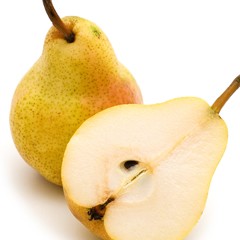Pears
 Commercial pear production is concentrated in the Pacific Northwest. New York grows approximately 1200 acres of pears, nearly half of which are located in eastern NY. European type pears predominately grown in the state including varieties like Bartlett, Bosc and D’Anjou. Asian pears, also known as “apple-pears” because of their apple-like texture, are grown on a few fresh market operations.
Commercial pear production is concentrated in the Pacific Northwest. New York grows approximately 1200 acres of pears, nearly half of which are located in eastern NY. European type pears predominately grown in the state including varieties like Bartlett, Bosc and D’Anjou. Asian pears, also known as “apple-pears” because of their apple-like texture, are grown on a few fresh market operations. U.S. per capita consumption of fresh pears was 3.2 pounds in 2009. Per capita consumption of all pear products was about 7 pounds in 2010. About 60 percent of the U.S. pear crop is sold as fresh and 40 percent is processed, primarily in the form of canned product.
Over the last 20 years, Cornell research and extension projects have helped growers increase yields and fruit quality by increasing tree densities and improving labor efficiency. We estimate that profitability of new high density orchards is 100 to 300% greater than the traditional low-density orchards. For more information about tree fruit production, please visit the Cornell Tree Fruit website at http://www.fruit.cornell.edu/tree_fruit/index.htm.
Prepping Your Air Blast Sprayer for Spring
Mike Basedow, Tree Fruit Specialist
Eastern New York Commercial Horticulture
Last Modified: March 12, 2020
Sprayers must be regularly checked over to ensure that proper maintenance has been carried out and that no outstanding repairs need to be done. Faulty sprayers contribute to increased drift levels and waste money through inefficiency and overuse of chemicals.
2019 Eastern New York Fruit & Vegetable Conference Tree Fruit Presentations
Last Modified: April 3, 2019

Presentations from the 2019 ENYCHP Eastern New York Fruit & Vegetable Conference held February 19-21 for the tree fruit sections.
2018 Eastern New York Fruit & Vegetable Conference Tree Fruit Presentations
Last Modified: April 6, 2018

Presentations from the 2018 ENYCHP Eastern New York Fruit & Vegetable Conference held February 20th and 21st for the tree fruit sections.
New fungicides labeled for use in tree fruit - all Special Local Needs Labels
Deborah Breth, Integrated Pest Management
Lake Ontario Fruit Program
Last Modified: April 9, 2014
The new class of fungicides, SDHI's, are now registered for use in tree fruit. Fontelis was registered last season, and Luna Tranquility and Merivon were registered this spring. They are all registered in NY as "Restricted Use" fungicides. Due to the special restrictions for use in NY, they also are Special Local Need registrations. In order to apply these materials you must have a copy of the label and the SLN label in your possession. You can access these SLN and label to study or print at these links.
The Commercial Storage of Fruits, Vegetables, and Florist and Nursery Stocks
Craig Kahlke, Team Leader, Fruit Quality Management
Lake Ontario Fruit Program
Last Modified: January 13, 2014
The information contained in this preliminary version of HB-66 has been assembled from information prepared by nearly 100 authors from around the world. The version posted here is a revised copy of a Draft made available online in November 2002 for author and public review and comment.













































